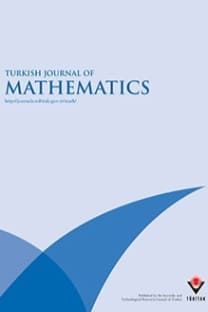A broken cycle theorem for the restrained chromatic function
A broken cycle theorem for the restrained chromatic function
___
- [1] Alon N. Restricted colorings of graphs. In: Proceedings of the 14th British Combinatorial Conference; Cambridge; 1993. pp. 1-33.
- [2] Björner A, Ziegler G. Broken circuit complexes: factorizations and generalizations. J Combin Theory Ser B 1991; 51: 96-126.
- [3] Blass A, Sagan BE. Möbius functions of lattices. Adv Math 1997; 127: 94-123.
- [4] Brown JI, Erey A. Restraints permitting the largest number of colourings. Discrete Appl Math 2017; 222: 76-88.
- [5] Brown JI, Erey A, Li J. Extremal restraints for graph colourings. J Comb Math Comb Comput 2015; 93: 297-304.
- [6] Brylawski T. The broken-circuit complex. T Am Math Soc 1977; 234: 417-433.
- [7] Brylawski T, Oxley J. Several identities for the characteristic polynomial of a combinatorial geometry. Discrete Math 1980; 31: 161-170.
- [8] Dohmen K, Pönitz A, Tittmann P. A new two-variable generalization of the chromatic polynomial. Discrete Math Theor Comput Sci 2003; 6: 69-89.
- [9] Dohmen K, Trinks M. An abstraction of Whitney’s broken circuit theorem. Electron J Combin 2014; 21: 4.32.
- [10] Donner Q. On the number of list-colorings. J Graph Theory 1992; 16: 239-245.
- [11] Erey A. An investigation on graph polynomials. PhD, Dalhousie University, Halifax, Canada, 2015.
- [12] Huh J. h-Vectors of matroids and logarithmic concavity. Adv Math 2015; 270: 49-59.
- [13] Kubale M. Interval vertex-colouring of a graph with forbidden colours. Discrete Math 1989; 74: 125-136.
- [14] Llamas A, Martínez-Bernal J, Merino C. On the broken-circuit complex of graphs. Comm Algebra 2010; 38: 1847- 1854.
- [15] Nakamura M. On the NBC-complexes and -invariants of abstract convex geometries. Discrete Appl Math 2009; 157: 1799-1805.
- [16] Thomassen C. The chromatic polynomial and list colorings. J Combin Theory Ser B 2009; 99: 474-479.
- [17] Toft B. Color-critical graphs and hypergraphs. J Combin Theory Ser B 1974; 16: 145-161.
- [18] Trinks M. A note on a broken-cycle theorem for hypergraphs. Discuss Math Graph Theory 2014; 34: 641-646.
- [19] Tuza Z. Graph colorings with local restrictions - A survey. Discuss Math Graph Theory 1997; 17: 161-228.
- [20] Wang W, Qian J, Yan Z. When does the list-coloring function of a graph equal its chromatic polynomial. J Combin Theory Ser B 2017, 122: 543-549.
- [21] Whitney H. A logical expansion in mathematics. B Am Math Soc 1932; 38: 572-579.
- ISSN: 1300-0098
- Yayın Aralığı: 6
- Yayıncı: TÜBİTAK
Eta quotients of level 12 and weight 1
Ayşe ALACA, Şaban ALACA, Zafer Selçuk TUNCER
When do quasinilpotents lie in the Jacobson radical?
Categorical structures of Lie–Rinehart crossed module
Maha MOHAMMED, LUTFI KALANTAN, HALA ALZUMI
On essential cohomology of powerful p-groups
Mohamed AMOUCH, Otmane BENCHIHEB
Univalent harmonic mappings and Hardy spaces
Ali EBADIAN, Saman AZIZI, Sibel YALÇIN
